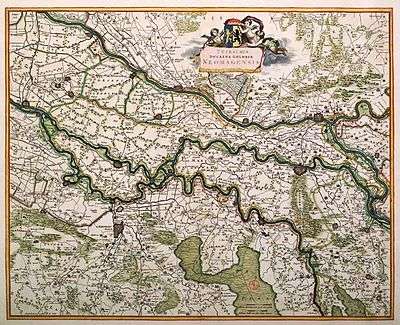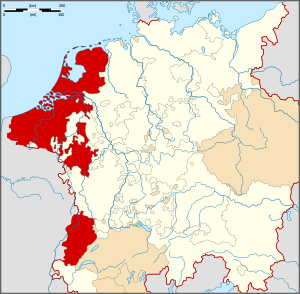Nijmegen Quarter

The Nijmegen Quarter (Dutch: Kwartier van Nijmegen) was the first of the four quarters in which the county, later duchy of Guelders was divided, as they were separated by rivers. In addition Guelders consisted of Zutphen Quarter, the Upper Quarter and Veluwe Quarter.[1] Each quarter had its own capital.
Geography
Nijmegen Quarter, Zutphen Quarter and Veluwe Quarter are the three downstream Lower Quarters that seceded in 1581 to the Dutch Republic, and constitute the present day Dutch province of Gelderland. Nijmegen Quarter with its capital at the city of Nijmegen, included the area between the Meuse and Rhine with the exception of the Cleves enclave Huissen and the independent counties of Buren and Culemborg, that were much later seceded to the Netherlands.[2] The quarter was divided in Nijmegen, Rijk van Nijmegen, Land of Maas and Waal, the Bommelerwaard and Betuwe. The main cities were then Nijmegen, Tiel and Zaltbommel. The quarter had a private university in Nijmegen.[3]
Notes and references
- ↑ Prak, M.; Webb, D. (2005). The Dutch Republic in the Seventeenth Century: The Golden Age. Cambridge University Press. ISBN 9780521843522.
- ↑ Nijsten, G. (2004). In the Shadow of Burgundy: The Court of Guelders in the Late Middle Ages. Cambridge University Press. ISBN 9780521820752.
- ↑ Van Berkel, K.; Van Helden, A.; Palm, L.C. (1999). The History of Science in the Netherlands: Survey, Themes and Reference. Brill. ISBN 9789004100060.
